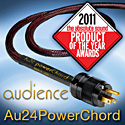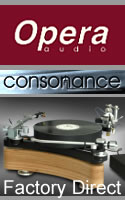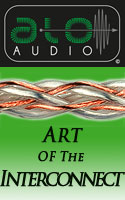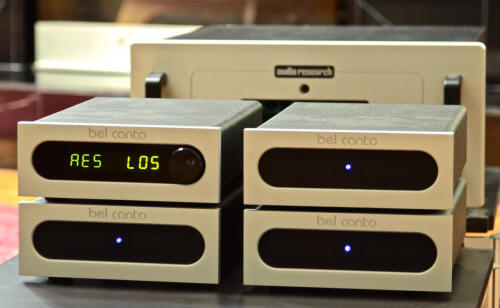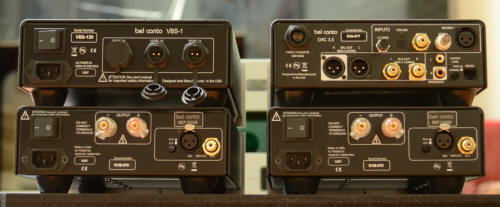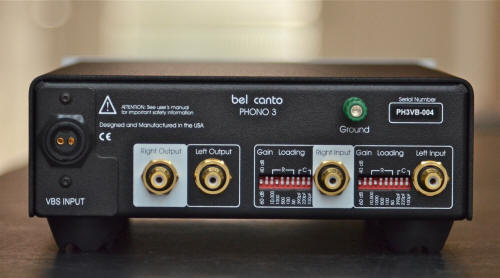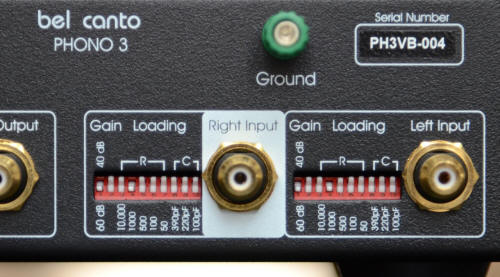|
|
You are reading the older HTML site
Positive Feedback ISSUE 59
bel canto A System Approach - The 3.5VB Dac/Preamplifier, Ref1000M Amplifiers, and Phono3 Phono Stage as reviewed by Robert Learner
Backstory I reviewed the Bel Canto 3.5VB DAC/preamp some months ago with the plan that this system review would follow shortly after. Months later, here it is—apologies to BC and the hostage components. The ability to do more with less is fundamental to progress—John Stronczer, founder of Bel Canto in my interview with him. Yes, an entire Bel Canto (BC) system could fit inside my Audio Research (ARC) Ref 210 mono amp. And it's anything but a 'lifestyle' component with sound quality priority number eight or so. I will let go of my tube amps kicking and screaming. But the waste is pretty hellacious; 380 watts at idle, maybe 20 percent efficiency. That's 80 percent of the electricity turned into heat and 20 percent turned into music. So-called digital amps have taken far more heat in the audio world than they've given off. Lame joke aside, they weren't taken seriously to begin with and sometimes with good reason. It takes guts and commitment to principle to start and stick with them through the years which is exactly what Bel Canto has done. Their amps are now in their third iteration when some other name companies are just putting out their first production. Same story with DACs—their first, the Aida, came out in 1991, when they probably had to explain to some what a DAC was. The 3.5VB on review here is several generations away from that. Net is a wealth of engineering experience in every Bel Canto component. Story The Bel Canto system reviewed here is comprised of the Ref 1000M mono amps, Phono 3 phono stage and DAC3.5VB digital to analog converter and preamp—these are their top-of-the-line components. The two source components are powered by the Virtual Battery Power Supply (VBS), a low noise standalone unit that can juice up to three compatible BC components. Whereas in my review of the 3.5VB it was compared to a few other DACs, this review will primarily examine the BC as a system with little examination of the individual component's part in the whole. The band rather than the individual players. The Ref1000M monos put out 500 watts into an 8 ohm load, doubling to 1000 into 4 ohms. The M designation, formerly MkII, refers to power supply improvements over the earlier model. Owners of that model can upgrade for the cost difference between the old and new amp. It's heartening when a company looks out for its existing customers. Hey, these guys might be in it for the long haul! More on that later.
Around back of the corporate face, a power switch, IEC connector, WBT speaker binding posts, and both XLR and RCA inputs with a switch to toggle between them. A 12V trigger for turn on would be nice though these amps don't use much power at idle, so leaving them on is a relatively minor issue.
The Phono3 has RCA inputs and outputs, a two pin connector for the umbilical to the VBS power supply, and a series of DIP switches for each channel to set cartridge resistantce, capacitance and gain. For this review I was using a Dynavector XX2mkII cartridge hooked to an Audiomods arm on a Hanss T-20 table. More detail on the DAC 3.5VB can be found on the BC website—for this review I primarily used the digital out of a Squeezebox into one of its S/PDIF inputs, and the analog input for the vinyl. Digital files streamed were primarily Apple Lossless from CD rips, and some 24/96 FLAC and AIFF downloads from HDtracks and Rhino. The 3.5VB handled all sample rates without issue. Most of the listening was done through my Scaena 3.2 speakers which are highly revealing of what's in front of them. As they require four channels of amplification (a pair for the towers, a pair for the woofers), I borrowed an additional pair of 1000Ms for the review. Sound While in college last century, I took a class on revolutions. Among others, we studied the Mexican uprising and were given a choice of books to read. The professor described one as being beyond reproach analytically, and the other as more concerned with conveying the 'smell of the enchilada'. How do you like your reality, straight up, or with a bit more of an impressionistic spin? For history, I'll take the enchilada. With music, I'll take the reverse as the circumstances are different. Although I might enjoy this or that interpretation of what's on the disc, what the artist intended, I'd rather a component that doesn't editorialize. Among other things, such components inevitably diminish good recordings. Bel Canto focuses on fidelity to the source; passing on the disc's information as cleanly as possible. But that isn't to say that they don't capture the smell of the enchilada as well. What's impressive is that upon hearing the components, you immediately sense their fundamental honesty. As a system, the initial and a lasting impression is of sound very clean and dynamic. The sound is smooth on smooth recordings with no sense of limited frequency extension. Transients are sharp but not hard, and resolution is top-notch. Note that I value resolution more than some—I've yet to hear 'too much detail'. Not only do I find it indicative of better components and a worthy goal in and of itself, but the texture it provides ups my involvement, particularly on good studio recordings. The Cowboy Junkies cover of Springsteen's 'State Trooper' on Whites Off Earth Now is a superb recording. The sound was textured and detailed through the BC system. A guitar hit that jumps like lightning out of the black at one point—dynamic compression is not uncommon to experience here—felt like I'd mainlined the note. It stood me up as it should. The resolving power of the system also prevented watering down of microdynamics, a phenomenon that sucks the life out of music. Listening to the vinyl of the same song yielded a similar experience with a bit more liquidity and flow, but a touch less detail. This is likely less a comment on the Phono 3 as it is on my analog pathway, which may be a bit noisier than the digital feed. The opening guitar on the HDtracks 24/96 flac of 'Come As You Are' on the remaster of Nirvana's Nevermind sounded liquid yet detailed. The BC system captured the bolder, cleaner sound of the remaster making for a more exciting listen versus the original version. Bel Canto vs. Audio Research systems It was impractical to swap systems in and out, but sonic memory suggests that my reference ARC Reference 5/210 mono amp combo at roughly three and a half times more expensive (four if you include an ARC DAC) adds dimensionality, a bit more transparency and 'blackness of background', and some more purity in the high frequencies. The difference is not subtle nor does it diminish the excellence of the BC system. Similarly, my Klyne phono stage adds a bit more body and image density to the music, but it's more than twice the price of the Phono3. Really it points to the value here, $39K of ARC equipment (not including a DAC) versus a $10K complete BC system. Note too that you can shave off another two grand by dropping down to the Ref500M amps: 'only' 250 watts of power, and likely very similar sonics to the 1000Ms. Bottom line is you have to spend a LOT more to outperform these components. Conclusion I feel like I know what future Bel Canto components will sound like: increasingly transparent and dynamic, more resolved—ever closer to the straight-wire-with-gain ideal. I predict no 'revolutionary advances' or 'stunning breakthroughs'. Not expected either are new models that aren't legitimate advances on what came before. And if the old model Ref1000 and DAC3 are a guide, owners will be able to upgrade at a very fair price. That's admirable commitment to existing customers, real value, and indicative of solid design – the wheel isn't reinvented every time around, 'merely' improved. This may sound boring, but it speaks to the reality of the pace of engineering, and to corporate integrity. You can buy Bel Canto and know you're at or near the state-of-the-art, and paying a very fair price. This is peak of the value curve stuff. Bel Canto has been around for twenty years and should be thought of with the other benchmark audio brands out there. They're at the forefront of digital playback and amplifier technology. Here's to twenty more boring years. Robert Learner
Bel Canto Design
3.5VB
Ref1000M mono amps
Phono3VB
|
